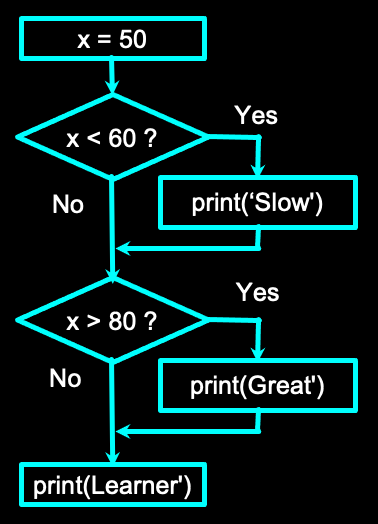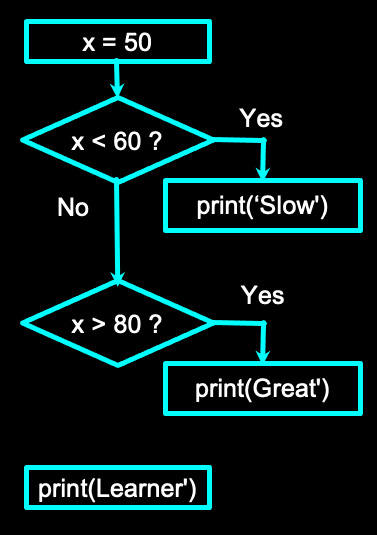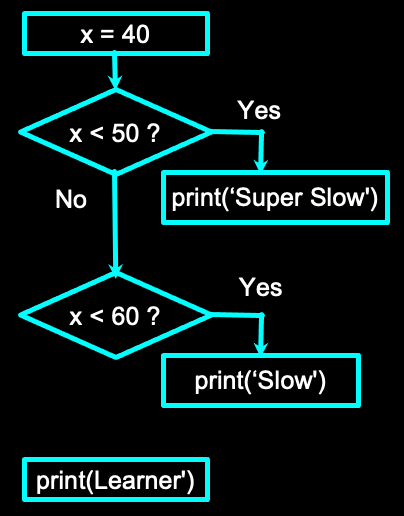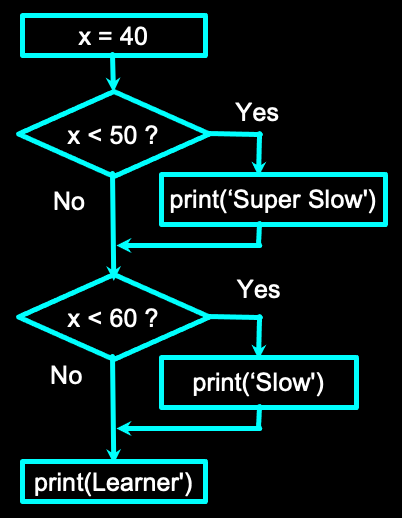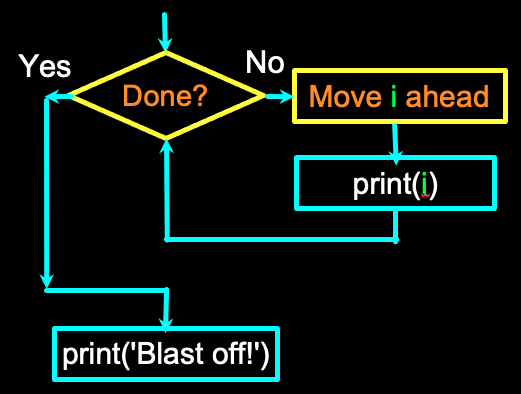test2. Python Programming Review
Review: Introduction to Computer Science 計算機概論
- Variables, Expressions, and Statements (PY4E Ch2)
- Conditional Execution (PY4E Ch3)
- Functions (PY4E Ch4)
- Iterations (PY4E Ch5)
Variables (PY4E Ch2)
Variable Assignment
- Use
=to assign variables - Assignment Statements: Variable name
=Value (Fix value/Constants, other variables)
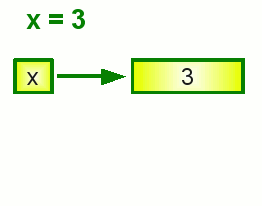
Variable Assignment
Variable Name Rules
- 不可使用保留字Reserved Words
- 會變色的基本上都是保留字,如
True,False等,在Python有功能的字串
- 會變色的基本上都是保留字,如
- 只能由數字
0-9、字母A-Za-z,或是底線組成_,且不可以數字開頭 - 大小寫敏感
- 建議要是看得懂的字
Data Types 資料型態
- 文字 (text, string, character)
- 數值 (numeric)
- 布林變數 (Boolean, logic)
- 日期 (date)
文字 (text, string, character)
- 一般文字,使用
單引號或雙引號標註,或是使用str(文字內容)宣告 - 就算內容為數字,只要使用雙引號標注,或是
str宣告,即為文字型態(除非有做轉型)
數值 (numeric)
包含整數 int與浮點數 float等型態。
整數 int:正數或負數,無小數點
- 直接指定,或是使用
int(數值)宣告整數 - 若
數值非整數,則無條件捨去 - 若
數值是文字型態,則強迫轉型
數值 (numeric)
包含整數 int與浮點數 float等型態。
浮點數 float:正數或負數,有小數點的數值
- 直接指定,或是使用
float(數值)宣告整數 - 若
數值為整數,則自動增加小數點 - 若
數值是文字型態,則強迫轉型
布林變數 (Boolean, logic)
True or False
日期 (date)
Python中並無內建的日期型態,必須使用datetime套件,使用前要記得載入(import)
日期 (date)
當需要用載入套件的功能時,結構為:套件名稱.套件功能或資料類型(可能有多層)
如datetime.datetime.now():
- 第一個datetime為套件名稱
- 第二個為套件內資料類型,有
date,time,datetime等,可查閱文件 .now()為更進一步的功能(取得今日的日期物件)
日期 (date)
取得日期後,日期物件有許多內建的功能
- 如
.year,.month等 - 可查閱文件
日期 (date)
也可直接新增指定日期物件,使用方法為:
datetime.date(年,月,日)datetime.datetime(年,月,日,時,分,秒)- 時分秒不指定會直接使用預設值 (0時0分0秒)
Data Types 資料型態 - Recap
- 文字 (text, string, character)
- 數值 (numeric)
- 布林變數 (Boolean, logic)
- 日期 (date)
Conditional Execution (PY4E Ch3)
Operator 運算子
+加 /-減 /*乘 //除>大於 /<小於 /==等於 /!=不等於and且 /or或
+加 / -減 / *乘 / /除
Numeric Expressions
>大於 / <小於 / ==等於 / !=不等於
and / or
Hands-on
- 宣告一個文字 “15”
- 宣告一個數字 10
- 試著相加看看?是否能相加?錯誤訊息的意思是什麼?
if
if & else if (elif)
if & if vs. if & else if (elif)
if & else
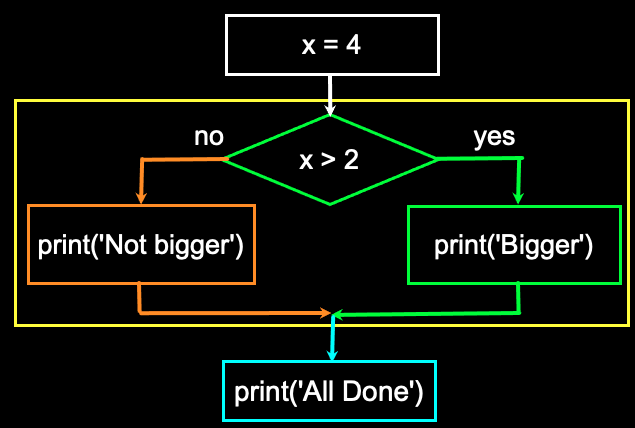
try except
You surround a dangerous section of code with
tryandexceptIf the code in the
tryworks - theexceptis skippedIf the code in the
tryfails - it jumps to theexceptsection
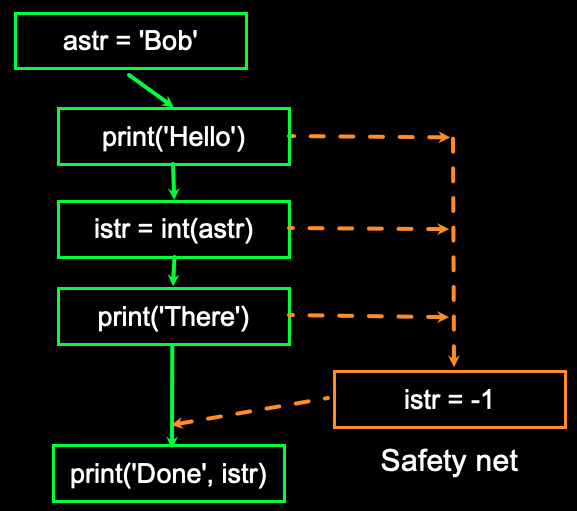
try except

Hands-on
Write a program to convert score to the grade and print the grade according to the following criteria:
>90: A
>80 and <=90: B
>=60 and <=80: C
<60: D
Assign 76 to variable score, check the output
Conditional Execution - Recap
- Operator 運算子
+/-/*//>/</==/!=and/or
- if
- if & elif & else
- try except
Function (PY4E Ch4)
Function
Stored and reused steps!
- Built-in functions
print('123'),int('123'),input()
- Functions from libraries
datetime.date(2025,1,23), fromdatetimelibrary
- Self-define functions
Function 函數使用
Function_name(Argument)print(variableor “value”)
function_name(Argument 1,Argument 2,…)- 多個參數用
,分隔
- 多個參數用
Function Definition 設計函數
We define a function using the def reserved word
Function Definition 設計函數
Function return value
Hands-on
Rewrite your pay computation with time-and-a-half for overtime and create a function called computepay which takes two parameters ( hours and rate).
Enter Hours: 45
Enter Rate: 10
Pay: 475.0 (475 = 40 * 10 + 5 * 15)
Function - Recap
Function_name(Argument)deffunction name(arguments):
Iteration (PY4E Ch5)
Repeated Steps
- Loops (repeated steps) have iteration variables that change each time through a loop.
- Often these iteration variables go through a sequence of numbers.
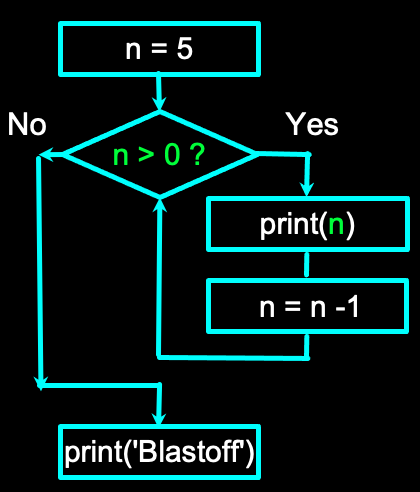
while
for loop
break
The break statement ends the current loop and jumps to the statement immediately following the loop
continue
The continue statement ends the current iteration and jumps to the top of the loop and starts the next iteration
Hands-on
Print the following pattern
1
1 2
1 2 3
1 2 3 4
1 2 3 4 5Iteration - Recap
- while
- for
- break
- continue
